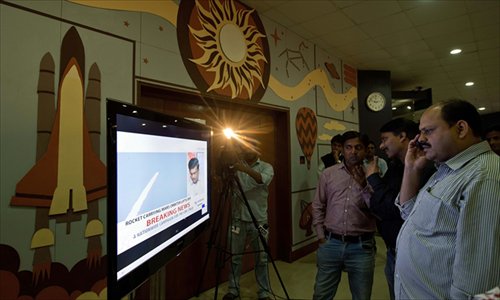India launches Mars mission

Indian visitors to the Nehru Planetarium watch the live telecast of the launch of India's Mars Orbiter Mission in New Delhi on Tuesday. The country aims to become the first Asian nation to reach the red planet with a program showcasing its low-cost space technology. Photo: AFP
India successfully launched its first rocket to Mars on Tuesday, seeking to install a satellite to orbit the red planet for information, in a mission that could make India Asia's first nation to get closest to Mars.
The rocket blasted off the southern coast of Sriharikota this afternoon carrying a 1,350-kilogram unmanned probe and was set to travel for around 300 days to deep space to achieve orbit around Mars by September 2014.
Some analysts say the launch is a clear move in India's race against China but some Chinese experts caution against the rush to compete over Mars and that space programs should move ahead in accordance with China's own economic and social development and needs.
The Mars Orbiter Mission, called "Mangalyaan" in the Hindi language, is India's first attempt at inter-planetary travel. It was announced 15 months ago by Prime Minister Manmohan Singh.
"With the mission launched within a very short period, India eyes the political influence hereby brought and intends to be the first one in Asia that orbits Mars," Jiao Weixin, a professor at the School of Earth and Space Sciences at Peking University, told the Global Times.
The real test, however, lies in the probe's actual success in achieving orbit around Mars, he added.
K Radhakrishnan, chair of the Indian Space Research Organization (ISRO), told the BBC on Tuesday that the country was just in "a race with itself."
India's space exploration program started in 1963, its "Chandrayaan" satellite found evidence of water on the Moon five years ago and India is still looking to land a wheeled rover on the Moon next year.
"It's natural to have competition in science and technology development. The launch will serve as a boost to India's national strength and space technology," a space expert with the Chinese Academy of Science, who requested to remain anonymous, told the Global Times.
Mars probes have high failure rates as has been the case with more than half of the tests.
The United States has been most successful in sending probes to land on Mars, the most recent being Curiosity in August 2012.
Europe and Russia have sent probes to orbit the red planet as well.
Japan's Nozomi orbiter failed in 2003, and China's Yinghuo-1 with its Russian carrier was lost in space last year. China has focused on its moon missions in recent years after a series of successful launches of manned spacecraft of the Earth's orbit.
A lunar probe, Chang'e-3, is expected to blast off at the end of this year for a first moon landing.
But experts say space programs are not based on competition but overall development.
"The space missions we conduct are planned according to the nation's strategic development. In fact, China is technologically able to launch Mars missions now," the anonymous expert said.
His opinion was echoed by Jiao, who said China is more focused on the success rate of such missions and whether there will be technological breakthroughs made during the process, instead of competition.
India spends about $1.1 billion on space programs a year and the Mars mission costs $73 million, less than a sixth of NASA's yet another Mars mission due to be launched later this month.
But the Indian government was criticized both at home and abroad for spending resources on space projects while millions of Indians struggle with poverty.
ISRO argues that its technology has helped economic development through satellites which monitor weather and water resources and enable communication in remote areas.
Agencies contributed to this story